Pawpaw Panache
Finding your first pawpaw is a thrilling moment.
I can remember exactly where it happened and when. It was the summer of 1987 in Longwood, Florida, in The Springs, a gated community, along a nature walk. I happened to glance over and saw a pair of horribly stunted misshapen green pears. And as is often the case, once one gets the image of the plant in the head by meeting it in person, one begins to see them. Their most common appearance in Central Florida is along the margins of Interstate 4 in the Deland area, and of course, pastures.
Wild pawpaws fall in the same category as gopher apples. The woodland creatures usually find them first so you rarely see a ripe one. The fruit is edible straight from the tree but palatability varies. There are two general types. One ripens early and is large with flavorful yellow flesh; the other is often smaller, ripens later, and has white, milder flesh. You can also divide pawpaws another way, Florida and all others. Florida’s pawpaws tend to be shrubs, if not dwarfs. They are: Asimina obovata, Asimina incana, Asimina reticulata, Asimina longifolia, Asimina pygmaea, and Asimina tetramera. Farther north one can find the Asimina triloba reaching small tree height and in the coastal areas Asimina parviflora. While I have not personally tasted them all Dr. Daniel Austin in Florida Ethnobotany says he presumes they are all edible.
Pawpaws are rich in nutritional value, including high levels of vitamins A and C. The downside is they don’t ship or store well, on par with loquats. Also they severely nauseate some people, can cause a rash when handled, and the seeds contain a depressant. Incidentally, the fruit is the largest native North American fruit and is heavy on the protein side.
Pawpaws are also a little difficult to cultivate. In fact, they are really hard to cultivate. They need a lot of pampering for a few years to get them started, after that they are quite free of problems. They also attract a wide variety of butterflies. Those who champion the cause of pawpaws think that if they can persuade nurseries to pay more attention to the plant it can be a commercial success. It has few pests so it can be grown organically with little fuss. There might be even pawpaws on your grocery shelf in a few years. That would depend upon the lawyers.
Like all plants the pawpaw is a mini chemical factory. The Indians used dried pawpaw seed powder to control head lice and pharmaceutical preparations today still use pawpaws for that. The leaves are diuretic and the bark yields a strong fiber for cordage. It also belongs in a family of fruit trees that are suspected of inducing Parkinson’s Disease. That is currently being researched. Pawpaw has not been indicted but to a lawyer all that might be close enough to keep the fruit off the grocery stores shelves. You might have to forage for pawpaws or grow your own. Which reminds me, historically, the pawpaw was under cultivation by Indians east of the Mississippi when de Soto traipsed through in 1541. Chilled papaw fruit was a favorite dessert of George Washington. Thomas Jefferson planted some at his Monticello. I don’t recall of either dying from Parkinson’s.
As for its usual genus name, Asimina (uh-SIM-min-nuh) nearly any guess is as good as any other. My best deduction is the Indians called the bush Assimin (“min” in Algonquin means food, still found in “persimmon.” ) Assimin would be fine enough but then European languages and writers get involved. The early French inhabitants of Louisiana, called the fruit “Asiminer” from which we get the genus name. This is somewhat close to the Latin word for monkey, simia. That led to an early reference to calling the plant “monin” which was an old French word for monkey. That came from the Greek word for monkey, maimou. It changed through Latin into the romance languages as monin, mouninu, monnino, and monin. That leads folks to think the fruit had something to do with monkeys but I think it was just an assumption of one botanist who thought Louisiana French were referring to a “monkey plant.” Further, the pawpaw is North American and there are no native monkeys.
One Florida version is Asimina reticulata, (reh-tick-yoo-LAY-tuh) meaning the veins in the leaf have a net pattern. It can be found in slightly damp or occasionally damp areas. Another is Asimina obovata (oh-bo-VAY-ta) meaning egg-shaped leaves. It likes it dryer ground can grow twice as tall as the reticulata. The others are more or less reported, not the most common of shrubs. Locally pawpaws are rarely over four feet high whereas farther north the grow into trees. The A. obovata is listed as rare and the A. tetramera endangered.
One would think pawpaws would be a bit easier to explain, but no, and it also points to one of the problems of the cut-and-paste Internet. Many say pawpaw (or papaw or paw-paw) is a corruption of the American Indian word papaya, a version or cognate shortened by the Spanish. That’s not too bad, no great stretch there. And that it came originally from native Americans seems reasonable. Others, no doubt copying the same wrong site, note that it is Indian then make a huge leap across the Pacific and say it is from the Hindi language, you know, near China… and then younger folks wonder why older folks don’t trust the Internet…
Two aspects of the pawpaw I’ve found interesting is first it is in the Annonaceae family and closely related to magnolias though actually much older than the larger magnolias. The little ol’ pawpaw came first first. Next is that it is pollinated by carrion flies and insects attracted to fetid odors. Growers often put roadkill or rotting meat in their groves to attract the pollinating flies. Now there’s a tasty thought…
How to spell it… dictionaries are split, pawpaw, papaw… if you go back to the original it should be “papa” said pawpaw. In that regard papaw seems half-hearted. The USDA says pawpaw, Dr. Austin, ever sensitive to language’s influence on botany, went with pawpaw. Pawpaw eliminates mispronunciation, looks balanced to me and reflects the balanced sound the ear hears… always the musician…
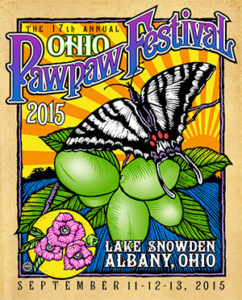 And in case you wondered since 1994, Kentucky State University http://www.pawpaw.kysu.edu/ has served as the USDA National Clonal Germplasm Repository, for Asimina species, as a satellite site of the NCGR repository at Corvallis, OR. There are over 2,000 trees from 17 states there on 12 acres at the KSU farm. Researchers evaluate the genetic diversity contained in wild pawpaw populations so that unique material can be added to the KYSU repository collection to be used in breeding. And for an unusual recreational and educational opportunity, visit the Annual Ohio Pawpaw Festival in September Lake Snowden in Albany, Ohio for three days of Pawpaw music, food, contests, art, history, education, sustainable living workshops and activities for the kids! http://www.ohiopawpawfest.com/ .
And in case you wondered since 1994, Kentucky State University http://www.pawpaw.kysu.edu/ has served as the USDA National Clonal Germplasm Repository, for Asimina species, as a satellite site of the NCGR repository at Corvallis, OR. There are over 2,000 trees from 17 states there on 12 acres at the KSU farm. Researchers evaluate the genetic diversity contained in wild pawpaw populations so that unique material can be added to the KYSU repository collection to be used in breeding. And for an unusual recreational and educational opportunity, visit the Annual Ohio Pawpaw Festival in September Lake Snowden in Albany, Ohio for three days of Pawpaw music, food, contests, art, history, education, sustainable living workshops and activities for the kids! http://www.ohiopawpawfest.com/ .
Green Deane’s “Itemized” Plant Profile
IDENTIFICATION: Shrubs or small trees, three to 40 feet, 15 common, evergreen in southern area, deciduous in northern area. Leaves alternate, simple ovate, smooth edge entire, length varies with species, flowers foul-smelling of rotting meat, single or in clusters, three large outer petals, three inner smaller petals, white to purple or red-brown. Fruit like cylindrical pears, misshapen, many seeds; green when unripe, maturing to yellow or brown, flavor similar to both banana and mango.
TIME OF YEAR: End of summer, fall
ENVIRONMENT: Rich bottom lands to rain-watered pastures, open areas, beside open areas. The two most common places I find it is at the base of tall pines or in cow pastures.
METHOD OF PREPARATION: Used like a banana, raw or cooked, as in baked desserts, ice cream, pastries, or in making beer. Don’t eat the skin and don’t eat the seeds. Chewed seeds will cause digestive problems, whole seed usually pass through. Try only a very little at first. Some people have a very several allergic reaction to pawpaws.

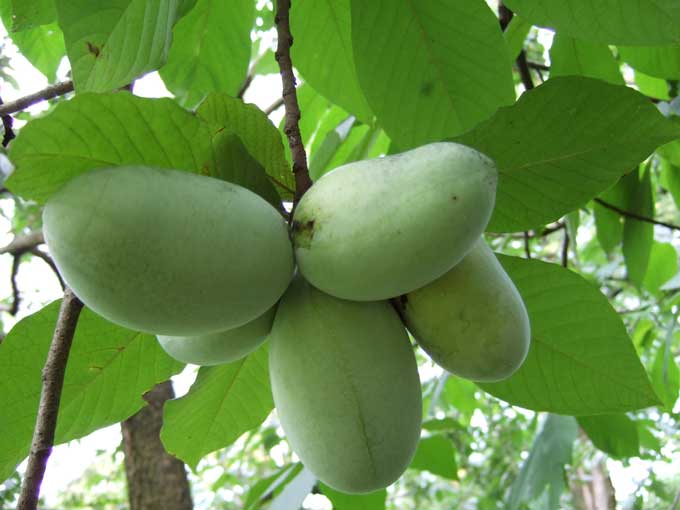
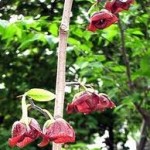
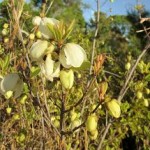
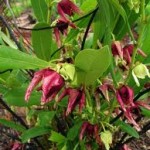
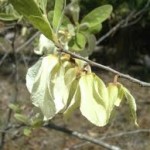
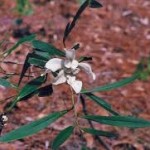
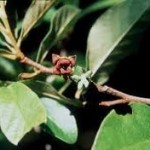
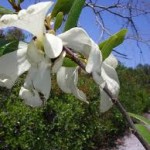

Hi Deane
Thanks for the brilliant website, I am a recent subscriber! I thought I should comment on your pawpaw post because here in Durban (South Africa) pawpaw do literally come up like weeds in my garden. However, it is the “Carica papaya” and not the plants you mention – which I learned about for the first time on your site. As a fledgling forager, one of the most important things I have learned is that common names are not to be trusted and even, as you mention in some of your posts, botanists sometimes confuse identification of plants! The pawpaw fruits in my garden are large and delicious but mostly stolen by the monkeys and mousebirds!
All the best
Karen
Thanks for writing. Papaya and papaw (orpawpaw) come from the same native term and in some places and languages are used interchangeably.
Oh wiw! I am also so glad to read your article! Tjis is the first year ive ever seen pawpaw and have been watching for many florida years…and its actually in my yard!!! I hope i make it b4 the animals!!
Interesting read on Florida’s more common Pawpaws. The Pawpaw Chapter of the FNPS hopes to do its first collaborative survey of a rare Pawpaw Relative, Yellow Squirrel Banana (Deeringothamnus rugelii) which only grows in Volusia County. This one is slightly similar to another on the southwest side of the state, Deeringothamnus pulchellus. D. pulchellus caught the attention of an early botanist, John Kunkel Small…primarily by its fragrance before it was even seen. So not all pawpaws smell alike! These more rare pawpaw cousins, possibly developed independently in their isolated communities during the geologic periods on inundation. They belong to the Annonaceae Family so are related to pond apples of more tropical south Florida. There are more questions than answers when it comes to the puzzling pawpaws! More reading in the Fall 2007 Palmetto, The Quarterly Journal of the Florida Native Plant Society.
Sonya, How can I get involved with FNPS ? I have a knack for finding habitat in the various human-repudiated areas within urban areas and would like to see a STOP of complete mowing of certain areas like ditch/creek/watersheds areas. I saw an otter as roadkill at 38thAv/66thSt StPetersburg Fl -IT KILLED ME 2C it….I collect seeds (if population seems ok) from these areas and put ’em in my yard … or hope they’ll wait till I have a larger property…. I hate commercial nurseries and being (part-time)in tree and landscape business reccommend planting or re-planting native ONLY wglenbateman@yahoo.com
I wish I had read this before I planted my pawpaw. I have had so many flies this year and a vague dead animal aroma (not strong). I didn’t even think that it might be the plant. One source had mentioned that it might have an aroma that some found unpleasant. That is a pretty mild description of the odor of carrion in my opinion. At least you have to get pretty close to the plant to smell it (within 20 feet or so). I thought the cats had been using the area as a feasting ground or something. Live and learn…
On growing pawpaw; the native grower I got mine from said there is no standard for whether or not they will live in your yard. He said they will either love it or hate it. Mine is planted within 12 feet of a long leaf pine on the south side of a densely treed part of my yard. It loves it there. Too bad the rest of my yard is downwind of it…
While out in the local wilderness off of the beaten path I came across, what I believe to be, A. reticulata. There were a few in the area, about 18 in. high and it was the flowers that caught my attention. I could see some fruits beginning on some of the flowers. Instead of one fruit at a flower though, I saw three. As I drew closer I took a sniff of the flowers and they did not smell of rotting meat at all. On the contrary, they were pleasant. I keep reading of this foul odor though. Is this species an exception?
They are not foul all the time, just when trying to attract a few carion flies for pollenation.
“•
The floral scents of these species are highly dynamic, varying between floral organs, sexual stages and species. Maroon-flowered species of Asimina produce ‘yeasty’ odors, dominated by fermentation volatiles and occasionally containing sulfurous or nitrogenous compounds. White-flowered species of Asimina and Deeringothamnus produce pleasant odors characterized by lilac compounds, benzenoids and hydrocarbons. Annona glabra produces a strong, fruity-acetonic scent dominated by 3-pentanyl acetate and 1,8-cineole.
•
The fermented/decaying scents of maroon-flowered species of Asimina suggest mimicry-based pollination strategies similar to aroids and stapeliads, whereas the pleasant scents of white-flowered species of Asimina suggest honest, reward-based pollination strategies. The scent of Annona glabra is typical of specialized beetle pollination systems common to tropical Annonaceae.” – New Phytologist
Volume 183, Issue 2, pages 457–469, July 2009
Hi all
A most welcome and interesting site! I live in Spring Hill, Florida, in SW Hernando County, on the west coast, not far north of Tampa. There are pawpaws growing in a number of empty lots in my area — in some quite built-up areas (and small lots as well); indeed, I pass some of these regularly, and I am terribly tempted to try and dig some up for my own yard. Some I have not identified as to species; but I certainly have identified Asimina obovata (its beautiful and fragrant banner-like blossoms are actually quite showy) and Asimina pygmaea (whose small purple-russet flowers are foul-smelling). Sometimes only one will be in a lot and sometimes both, as well as possible others. There is one lot nearby, for sale with a commercial zoning, with a dozen or more plants, one of the A. obovatas being a small tree of perhaps 7 feet height. This tree is now (as of the begining of June 2012) full of ripening fruits. I have considered asking the owners if I could abstract a couple of these plants, which would be destroyed if and when the property is built on. But I have heard that they are very difficult to transplant. Is there any hope in it? And are there any suggestions as to how to go about it? Many thanks for this posting!
You have the seeds paw paw? –
Asimina parviflora (Michaux) Dunal
Dwarf Pawpaw, Smallflower Pawpaw
I’m also in the springhill area and have some on my land I’m about to try airlayering. But something is eating small holes in the leaves all of them in the woods and then I just started a couple from seed they are already getting ate by this pest I haven’t seen yet. Hit me up on facebook if you want✌
my grandparent’s have pawpaw tree’s that are very tall,20 t0 30 feet. when the higher up fruit’s fall the small animal’s have a way of relocating the seed’s. I have found small tree’s growing everywhere. Even in the dirt cellar. so planting or scattering seed’s may be the best way to go
I grow pawpaws for a living and I wouldn’t suggest trying to dig one up. A pawpaw that is only a foot tall can have a six foot root on it. I grow six of the eight florida native species. You have the best luck with a container grown plant than digging one up. Terri
Terri, any tips for getting the seeds to germinate? We’ve had terrible results here in Maryland. – John
John,
After stratifying in a baggie of damp peat moss in the refrigerator for 3-4 months,I place them in treepots (bandpots) 9-14 inches tall or 2 liter plastic drink bottles with the top cut off.The media is half perlite/peat moss and the seed is planted about 1/2 inch.
I put the pots in plastic tubs and wrap the tubs with a heating blanket and keep the temperature around 80F. Brady
I remember reading a few years ago that if the paw paw seed dries out before planting, it cuts the chances of it ever germinating by more than half.
That depends on where you live and which species. South of the Carolinas the pawpaws tend to be shurbs and bushes more than trees.
Mr. Deane, you mentioned in your video that one could pick and ripen the fruit off the plant. How early is too early to do this? Do they need any special conditions to ripen or is on the kitchen counter at room temp acceptable? Thanks, John
they have a strong smell when ripe and usually you can squeeze the low branched ones, like with any skill it just takes practice and whatever your preference is, I frankly don’t like the really squishy ones but if you wait to long bugs will start eating them. Like right now in Maryland they are ripening and it is early October, October 3, 2014 to be precise. Just shake the trees with fruit and the ripe ones will fall. but don’t shake then so hard that you break branches.
Like more info on any thing.thanks.
I live in KY and can pass on a bit of info on the species we have here in IN, OH and KY. First of all they are fantastic eating. They can be used to make ice cream or simply mixed into plain yogurt. But my favorite use in in bread. Pawpaws can be substituted for bananas in any banana bread recipe. The important thing is that they be ripe.
It is VERY difficult to tell if the fruit is ripe when looking at it on the tree. The surest way to know that it is ripe is to pick it up off the ground. They should be soft. They DO NOT ripen well once off the tree so don’t pick them when they are firm. If you see some in the tree and are wondering if they are ripe, lightly shake the tree. The trees always have slight trunks and are easy to shake. If the fruit does not fall with a slight shake, it is not ready.
If you plant pawpaws you must have two unrelated trees to get fruit. They tend to send out runners and multiply that way far more readily than by seed. Anywhere you see a large patch they are likely all related and will not pollinate eachother. They like to start life as an understory plant at the bottom of a slope and will want sun as mature trees to produce fruit. This makes them VERY difficult to plant. Best to find them where they grow, usually near creeks.
They are fairly easy to identify. They have very large untoothed leaves that run alternately along the branches. There are two trees that can fool you that grow along side. One is the large leaf magnolia. VERY similar but gets quite a bit larger. Pawpaw trunks rarely get much bigger than say soda can. Also the magnolia leaves tend to spread out like fingers at the end of the branch while pawpaw leaves runn alternately down the branch. Another very similar tree as small saw tooth leaf edges. Pawpaws NEVER do.
They are best eaten when they are so ripe that the inside has an almost custard consitancy. They are so soft when fully ripe that handling them roughly will cause them to split open. The inside should be a creamy yellow.
One more hint. They have a very short shelf life and dont last long once they drop from the tree as many critters love em. Here is a nifty tip for successful foraging. They very often grow overhanging creek beds. This is a huge help and heres why: When they are ripe they sink. They usually dont fall until ripe, so if they drop into a slow flowing creek, they will simply go right to the bottom and stay there. The great thing about this is that they are out of reach from most wildlife and also easily missed as its the smell that attracts animals. The cool water and lack of oxygen also prolongs their life by several days. So if you see a tree overhanging a creek, look there first, its your best bet.
My Dad planted two paw paw trees about twenty years ago. They are about twenty feet high and produce alot of fruit. They will only grow in pairs. He loved paw paws as a boy, and finally got them to grow in Seville,Ohio. I am sorry to say that Dad never got to see His trees give forth there fruit, but thanks to Him all of His kids , Grandkids and Greatgrandkids have learned about the tree and to love it’s wonderful fruit.
How long was it til they fruited since he planted them. Im next door in Guilford township and am looking to planting some myself soon.
Taras is an English name?
Really enjoyed all the pawpaw info. I used to live in Ann Arbor, MI and created a small stand of them from seed and a few potted (bought) plants. I hoped to attract Zebra Swallowtails to my butterfly garden. No luck there, but we loved the fruit. I’ve lived now for 6 years near Fort Lauderdale, FL and would really like to acquire one of the local species for my butterfly garden here, but I don’t think A. Triloba can take zone 10. Do you know of any growers/sellers who could supply one of the local native plants? Thanks much, Tom Webb
The right person to contact regarding raising pawpaws where is Terri Pietroburgo in Leesburg, Fl.
1bushwoman@embarqmail.com
Will do. She looks like the right person.
Thanks much,
Tom Webb
Great website for pawpaws I live in Baton Rouge, LA and I purchased my two pawpaw trees a nursery in SC and I don’t know what type they are but they are about eight yrs old and seven feet tall and so far haven’t fruited at all.Phil
I will direct a few fellow students to look into this pawpaw as a possible identity of two trees, one six ft and one ten ft, seen in Hammock Park in Dunedin Fl. If so I’ll tell you; Pinellas county is a heavily humanized landscape. Not a one of us could do anything other than point out similarities to other “knowns”. Between avocado and magnolia but not dark green, looked like a young tree becoming woody and forming a tougher outer cambium toward the base and no flowering.
You might guess I never really got back to see the “suspect” shrub in Hammock Park, Dunedin, FL…all I can say it/they was on the western edge 20-30 yds from a neighborhoods edge…… land and wildlife is really WORKING to hold ground in our densely human populated peninsula of Pinellas County FL. I’d like to see every tractor/bulldozer operator have a degree in biology just to make sure no species ever has to succumb to humans'”success”(assuming they would make arrangements for the individual or at least its seeds!)….I always root for the underdog… especially if humans are the BULLY ! poor me- never even seen Assimina or Deerangothamnus…. that I recall. My nose and eyes are hoping…
I live in N. Virginia, and first discovered the pawpaw hiking and fishing the Potomac river. I’m new to foraging, and am afraid to eat most things I don’t know about very well. But pawpaws, in late August and September here, there’s almost no doubt when I first found one, I SMELLED it long before I found it on the ground, they smell fantastic, like over ripe banana, very strong sweet smell, and I hesitated, when I picked it up, it was so soft, I thought yes it must be rotten, but it smelled SO good…so I tasted it…oh boy…they taste fantastic, and I gathered up all I could find, read up on them on the internet and went back for lots more. But yes I can attest to the fact they do not keep well, you need to eat what you find pretty quick. They really are like a gift from God I think, like God handed you a really great piece of candy.
You have collected the seeds of Paw Paw in the woods?
I’ve been a bit obsessed with this plant since I first heard about it in my permaculture class a few years ago. I now live in southern Italy and was able to have an Asimina triloba shipped to me almost 2 years ago from a nursery in northern Italy. It’s alive, but not doing much. I later discovered that there needs to be more than one for pollination, so I guess that could be the problem, along with the fact that the soil is reddish clay and the summer climate very hot and dry.
Maybe I should have planted it under a pine tree, of which I have many!!
Anna Maria,… consider the climate type Asimina triloba is native to,… they basically require more than 500 hours of ‘chill’ during winter, and they don’t like dry-air warm-hot climate type, they like humid-air warm-hot summer climates.
And they need to stay moist, with sufficiently mulched soil. Put them in a cooler part shade spot, and/or north exposure, rather than a hot sunny spot with reflected heat or open exposure.
i recently ran into the pawpaw while doodlebuggin in marrieta ohio.i had fallen behind in the densely wooded hills and spotted the tree with rich looking green fruit ,i picked one up as they were lying all over and squished it open and tasted it on the spot .right away i knew it was edible so i brought the seeds back to texas to see if i can get them to grow .
John from Arlington,Texas Bought 2 Jan. 25, 2023. PB-NC-1 Pawpaw gallon seedling. Edible Landscaping Nursery. Don’t know about them. Let me know how yours turn out. Mine is planted in black soil. John
I am from Nebraska and have found many Paw Paw trees where I hike in the timbers. Yes ,the trees are usually found near a warm humid wet area in the deep hilled timbers reaching for sunlight. There are times I can reach them by grabing a limb and bending the tree down far enough for me to pick the fruit, but other times the fruit it 15 feet high or taller and can not be reached. I watch them grow into nice size fruit (simular to a kiwi) all summer long then by September they are falling from the trees but are hard to find because the timber weeds are high and the wild animals have found them before I get to pick up a few. A lot of people do not know what a paw paw fruit is , so I pick one or two just to show them off. I have tasted the cream filling and yes it is tasty. I get excited every time I find this patch of trees . I walk by them every summer knowing that this is a rare fruit in our area and I am not wanting a lot of people to know where this patch of trees are fearing that they will be picked and no seeds left behind for the reproduction of this interesting fruit. Live On Little Paw Paw Tree……: )
Does anyone know if Pietro’s Pawpaws is still in business? I’m trying to get a hold of some and haven’t been able to get a response.
Thanks.
You can try the master gardener show at volusia county fair grounds.
We have many Pawpaw trees in our park in a couple of different areas but I have never seen any fruit. Neither on the trees or on the ground. Why would that be/
I’m interested in some of the Florida species and varieties. Might they do better in subtropical parts of California?
Does anyone have seeds of some of these?
They have three pawpaw trees growing at the Fulerton arboretum.
From Farouk Hussein: I feel pleased when I find relationships such as “those creatures of the woodland getting ripe Pawpaw as after all this is their grocery store , as also the Pawpaw related to a mini chemical factory. I confess I’m myself have been confused the name “Pawpaw “ and thought of “Papaya” instead. Some of my people here also share the confusion as I observe when searching the topic. What is more important is that now I’ve been informed that Pawpaw is grown in Southern Sudan and that some folk are making profit from growing it besides the more familiar Papaya.
FYI This year at the WV Small Farms Conference I learned from a representative of the KYU Pawpaw repository that the repository Uses RoundUp on their Pawpaw orchards AND Trademarks all their cultivars.
The first pawpaw I tasted was from a tree growing in the University of Pennsylvania garden. I was hooked and bought several trees of mixed varieties. I’m hoping they’ll begin flowering in the next year or two. They took well, but they grow slowly here in the NJ Pine Barrens, even with all the pampering I give them.
And deer also nibble on them despite the toxicity of the leaves and branches, so I had to put cages around the smaller trees. The deer are so overpopulated and desperate for food they’re even eating yew bushes and columbines! But they won’t eat grass… go figure. Crazy things.
Pawpaws can be hard to raise.
Some observations from zone 6, southwest PA–I tried and failed to grow pawpaw trees when living in NE Ohio. When I moved to SW PA 3 years ago I again planted a variety of pawpaw trees (11 so far), in the partial shade along the uphill edge of the woods on my back property line. To my surprise they have all done well there and the most precocious tree, a Peterson “Susquehanna”, flowered this spring, although it got frosted out. The 2 trees I planted in the shade of the downhill woodline didn’t make it. The slope, soil, rainfall, and amount of sun are pretty much the same in both locations.
Although I circled each tree with a wire mesh cage to keep dogs, cats, poultry etc. away, I did not use any kind of sunshade or tree tube shelter like I did in Ohio. The pampered and cosseted trees in Ohio all died, the ones planted here under the “benign neglect” method are doing well, and I have no idea what made the difference.
The most interesting thing is that the 17 year cicadas who have decimated the fruit and nut trees around here have not touched the pawpaws. They are my only fruit trees that did not have to be wrapped up in tulle netting fabric. The Japanese beetles don’t like them either.
Pawpaws contain a potent natural class of insecticides called acetogenins which makes them all but immune to insect pests. Only the zebra swallowtail and a handful of other bugs are resistant to it. They are also the chemicals which can lead to a type of atypical Parkinsonism or tauopathy due to the accumulation of abnormal tau protein in neurons and the directly dopaminergic neurotoxicity of annonacin (a highly neurotoxic compound roughly 100 times more toxic than a classic compound used for simulating Parkinsons abbreviated as MPP). This effect occurs from either large doses or sustained long-term intake of the chemicals. One tropical relative, the soursop, is indicted for having high enough concentrations in the fruit to trigger the illness, but it requires a fairly frequent consumption rate. Casual, infrequent use causes no issues. And in pawpaw, annonacin is only present in leaves and seeds…. so don’t eat those and you’ll be fine.
Did you read the additional letter in the article about roasting and misusing the seeds?
Plant skunk cabbage around the base of the tree. It helps, at least here in Indiana.
The four trees I have in different locations are starting to pick up on growth, especially the one in my back yard which is now over 6 feet tall. That one may put out its first tentative flowers this year and I can try cross-pollinating them with pollen from some trees growing in the University of Penn garden (which should result in good pollination since they’re unrelated trees). The others are shorter, but branching heavily now and doing fairly well with a thick oakleaf mulch around their bases. I’ve also started some seedlings from Penn garden fruits (a wild variety, but delicious). For those who want to grow the seeds, they need to be planted IMMEDIATELY for best germination. They should overwinter in the tallest pots you can find outside in richly organic soil. They sprout very late, often not until late June, and only grow a few inches their first year… which I think is why many people think they won’t grow well from seed. I got over 50% germination, and have 7 seedlings. They’ll transplant well only once and generate a long taproot (hence using very tall pots to start the seeds is the best bet) and if they start to grow a root from the bottom holes, it’s time to get them in the ground, ASAP! The root is brittle, so be careful when transplanting. This can be helped by lining the pot with mesh to hold the ‘soil ball’ together… it’s not really a root ball because the Pawpaw doesn’t develop a dense root network. Indeed, if it stays too long in a pot it will quickly die. I suspect it must rely on mycorrhizae for its long-term survival, as do many shrubs and trees that do not produce many root hairs, which might also be why it’s beginning to adapt to my Pine Barrens soil since symbiotic fungi are widespread in our forests and can form thick masses of hyphae around roots of partner plants. I see this frequently with out native laurels, wintergreen, some berry bushes, scrub oaks, and sasafras.
Deer are in the same category as goats they are browsers, they won’t eat off the ground unless forced to by starvation, it has to do with being a ruminant and parasite control over the eons.
Stupid Paw-Paws are trying to take over my small yard in Connecticut! The squirrels bury the seeds and I get lots and lots of volunteers to find and kill every year. The one tree that is thriving of the original two, produces Paw-Paws without the other tree blooming! (Unless, there is one in the neighborhood that I don’t know about.) I like the fruit and give it to unsuspecting people to try. Either they like it or not.
They propagate by runners as well as seeds. So, any near the Mother are/may be clones of Her. They can’t pollinate each other.
If your tree is self fruitful you have a unique pawpaw tree. If the fruit is anything close to decent you should really look into propagating that tree. Right now there is no known self fruitful variety.
A small local nursery or farmers market booth should be put some money in your pockets for your volunteer plants. Put them in small pots and make some money.
would love to figure out a way to get your pawpaw shipped to me in Florida. It’s not so common around here anymore. It’s the host plant for the Zebra Swallowtail, which we are seeing less of due to the dwindling amount of pawpaw.
You should be careful giving this fruit to persons. Not doing it unsuspectingly! It states right in the article that a serious allergic reaction can happen!!!
Kentucky State University is doing lots of research on Pawpaws.
Even Pawpaw beer.
They also have seeds for a giant Pawpaw variety.
Lot’s of information on their website and facebook page:
https://www.facebook.com/ksu.pawpaw/
http://www.pawpaw.kysu.edu/
BTW- I have one growing in my yard and I have performed pollenation on the flowers by getting pollen on my finger and transferring to other flowers and it did make fruit — until a deer got them.
I’d love to come dig up some for my yard in CT. I’m in Westport. Where are you?
Hi,
I live in Fenton Mo. and in the last three days Sept. 5,6 and 7, I went to the paw paw patch that I found, with trees up to thirty feet. They are starting to fall and if I shake the trees very light they come down with a thud. I run so I don’t get hit. I have gotten about 15 so far and the trees still have alot more. I like to freeze the pulp to make bread later and smoothies with the fresh ones. I have alot of fun. Keith Bosso
We have huge pawpaw patches at a few regional parks in Northern Virginia. They’re all over the place, you just got to know what they look like. I can now spot a pawpaw patch from a mile away and have an instant urge to shake the trees. Harvesting pawpaws directly from the tree makes me feel human, alive.
I am doing research/studies on herbology and battlefield medicine during the civil war…uncertain about the Alzheimer relation to pawpaw..which inevitably would contribute to later in life disability of soldiers…any input????appreciated Kevin
I’m not too sure about that although any problem might be related to the seeds. I do now that cycad seeds are known to increase the Alzheimer’s rate.
Pawpaws are native to Virginia. We have several trees that we grew from seed & get lots of fruit. We have lots of Pawpaw trees in pots that we started. For us it is very easy to grow them. They are delicious!
Nice article! Love the rare photos of all the Annona species in the US. I actually own and operate a Certified Organic fruit tree nursery and pawpaws are one of our main specialties. We grafted about 30 cultivars this year. We also start seeds from excellent fruit for our Ultra-Select seedling line. Just wanted to let folks know we’re out here, and ship our trees and pawpaw seeds all over the US! http://www.peacefulheritage.com
I have a couple of pawpaw trees in my yard in DE, LOVE ’em! I got them as mere “twigs” from a nursery, but I won’t hold that against them. Make sure u wash the fruit before u peel them, I suspect the coating on the skin may be what discourages the bugs. I peel & seed the fruit then put them in plastic bags (squeeze excess air out) & keep them in the freezer so I have pawpaw for the whole year! Makes a great smoothie w/ organic almond milk & 1/2 of a ripe avocado, (a little honey is optional).
I love your site Dean!
Great article and comments i am in Australia we don’t have this plant here wild any way but i have seen the fruit before in a garden. Thanks stay safe and well everyone bs
I live in Central Florida and see PawPaws every so often – especially in cow pastures. I just saw one at the edge of a wooded lot a few minutes ago and decided to stop to take a better look. At roughly 7-8 foot tall, it’s the biggest wild specimen I’ve ever encountered in these parts.
I have photos but can’t seem to post them here from the phone.
Just to add my two cents to the misinformation about pawpaws. 1. If they don’t smell, they might not attract the flies. Turns out you can spray a light maple syrup (about the same as you get from tapping a maple tree without boiling it down) and that attracts the flies perfectly. 2. If you plant a pawpaw make sure to put wood chips and other mycorrhizal fungi encouraging stuff around the tree (it is naturally an understory tree and needs detritus for nourishment). When you are out foraging for pawpaws look around for maple trees to see if they are co-dependent or whatever that word that means symbiotic is.
I absolutely loved happening upon this page! Thank you for all of the great information! I never even heard of a pawpaw until last Sept. when my dad bought some land and we were walking through it last year. We first smelled that sweet, strong scent and had no idea what it was. After doing a little digging, I determined it was a pawpaw. But I still wasn’t exactly sure if it was really safe to eat or not from all of the conflicting information out there online. The two things I would love to know are: Is it okay to eat the ones that are not really soft? When I cut into it, it was more of a white color. I wasn’t sure if it was safe to eat an unripe pawpaw or not since I’ve read a few things about them having more toxin in them or something. And second, Is there any serious risk in eating pawpaws? I keep hearing so much about a risk of Parkinson’s disease, and I wasn’t sure exactly how much I should be afraid of this. Especially since I now have a rather sizable grove on my dad’s land I could eat from. The internet claims frequent eating of the fruit would put you at more of a risk, but how much is too much to eat of the sweet fruit? Love to hear more about this mysterious fruit I have practically just learned about!
Have you ever considered writing an ebook or guest authoring on other blogs?
I have a blog centered on the same ideas you discuss
and would love to have you share some stories/information. I know my visitors would value your work.
If you’re even remotely interested, feel free to send
me an e-mail.
No. I have a real book.
Thanks for finally talking about > Pawpaw picking up is rare – Eat The Weeds and other things, too < Loved it!